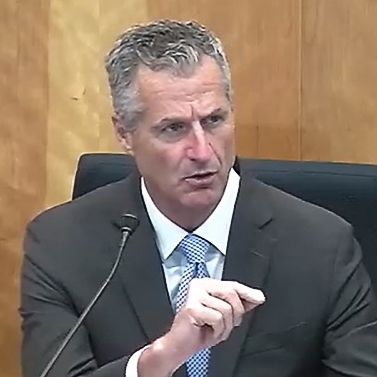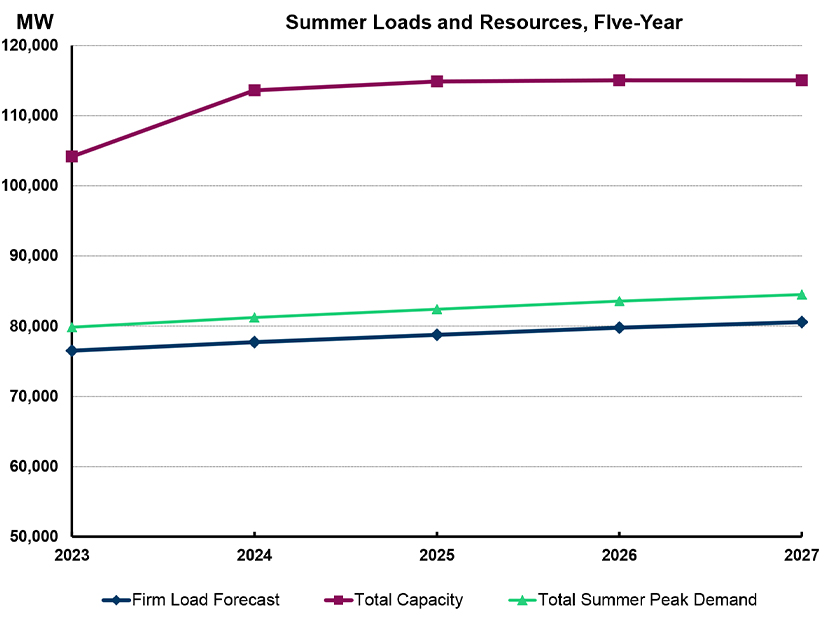Texas grid leaders met with reporters in Austin Tuesday to once again allay concerns about ERCOT’s management of the state’s electric supply.
“We’re ready [for the summer]. Our reforms are working. Our transition from a crisis-based business model to a reliability-based business model is showing results,” said Public Utility Commission Chair Peter Lake, referring to ERCOT’s conservative operations practice that has the ISO bringing on more reserves and doing so sooner.
“I want Texas to know that we will continue to operate with a margin of safety …. that will bring more generators online sooner rather than later,” he said.
Echoing Texas Gov. Greg Abbott, Lake said, “This grid is more reliable than it has ever been before.”
 ERCOT’s Brad Jones details the grid operator’s response during tight conditions this week. | Admin Monitor
ERCOT’s Brad Jones details the grid operator’s response during tight conditions this week. | Admin Monitor“We feel very confident about the summer,” ERCOT interim CEO Brad Jones said, pointing to a capacity planning reserve margin that has steadily increased from less than 10% in 2019 to 22.8% this year. That figure accounts for forecasted customer demand, emergency demand-reduction programs and “typical” unplanned outages and renewable energy production.
“As always, we have to be careful about those times where it’s both dark and still,” Jones said. “We have to make sure that we have the dispatchable generation to balance our fleet when wind and solar are not available, but we’re very happy to have that wind and solar development we’ve had over the past two years. It’s making our grid stronger.”
As Jones and Lake spoke, 12.6 GW of thermal generation was offline, an improvement over Monday’s 20% outage number. Wind and solar helped pick up the slack, as they have during recent days, by combining for about 29 GW of energy.
Demand peaked at just a bit more than 70 GW shortly before 4 p.m. CT Tuesday, the second straight day it has cracked the 70 GW mark.
‘Exactly as Intended’
But while May’s heat has set records, the state’s weather will only get hotter. ERCOT is expecting a record peak demand of 77.3 GW, according to its summer seasonal assessment of resource adequacy (SARA) released Monday. That would shatter the current all-time mark of 74.8 GW set in August 2019.
ERCOT expects to have 91.4 GW of resource capacity available to meet that demand during the summer, which extends into September. The SARA report includes seven risk scenarios that reflect different assumptions for peak demand, unplanned thermal outages and renewable generation output.
The ISO included the installed capacity ratings of individual generating units in the SARA for the first time as well as reporting the aggregate installed capacities of resource categories. Installed capacity ratings are based on the maximum power a generating unit can produce during normal sustained operating conditions.
Jones and Lake addressed ERCOT’s call for conservation last Friday when six gas-fired generators went offline for various reasons. Jones termed the call a “request” and noted ERCOT saw 300-400 MW of capacity freed up after the ISO issued an advisory. (See ERCOT Continues to Feel the Heat.)
“We were very surprised when several generators failed right before the peak,” Jones said. “Absent that, there would not have been a conservation appeal. It would have been a normal Friday. It wasn’t a conservation appeal. It was just a request to Texas to help us out over this weekend. It wasn’t that we’re in a dangerous situation at all; it was to make sure that we’re doing everything possible to keep the grid reliable.”
Lake was asked how he was so confident the lights would stay on given the heat yet to come and the possibility of further thermal outages.
“I know the lights are going to stay on because of all the reforms we put in place and because when we do encounter challenges like we saw last weekend, the multiple reforms are complementary and build off of each other to create even greater reliability,” he responded. “That’s how we know we can keep the lights on.”
The doubters remain. KUT Radio’s Mose Buchele was quick to paraphrase the press conference.
“Calling for statewide energy conservation out of the blue on Friday means the system is working well and exactly as intended,” he tweeted.
The grid operator on Monday also released its twice-yearly capacity, demand and reserves (CDR) report, a 10-year forecast of planning reserve margins (PRM) for the summer and winter peak load seasons through 2032. ERCOT defines the PRM as the percentage of resource capacity greater than firm electricity demand — which accounts for potential load reductions available through interruptible load programs — available to cover uncertainty in future demand, generator availability and new resources.
The CDR projects peak demand of 79.6 GW next summer that would erase this year’s expected peak. It forecasts a 36.2% PRM in 2023, 3.2 percentage points lower than the previous 39.4% margin reported in December’s CDR report. The decrease is due mainly to delays of planned projects that were previously expected to be in service by July 1, 2023.
ERCOT expects to add 13.1 GW of generation for the summer peak, with solar resources accounting for 11.7 GW available on an average basis during peak demand hours. Battery storage developers are expected to add 4.8 GW of capacity for summer 2023. The ISO currently assumes storage will provide ancillary services rather than support customer demand.
The reserve margin peaks at 46.2% for summer 2024.
The CDR expects summer peak demand to crack 90 GW in 2028, but projects energy efficiency programs to reduce that by 5.3 GW. Summer demand would peak at 95.7 GW in 2032, with energy efficiency reducing that by 7 GW, according to the report.
Winter demand would 74.7 GW during 2032-33, with the same assumed energy efficiency reduction. The CDR assumes only minimal increases in gas capacity by then, with no new contributions from coal or nuclear. Solar is projected to provide more than 31 GW, with an 81% capacity factor.




